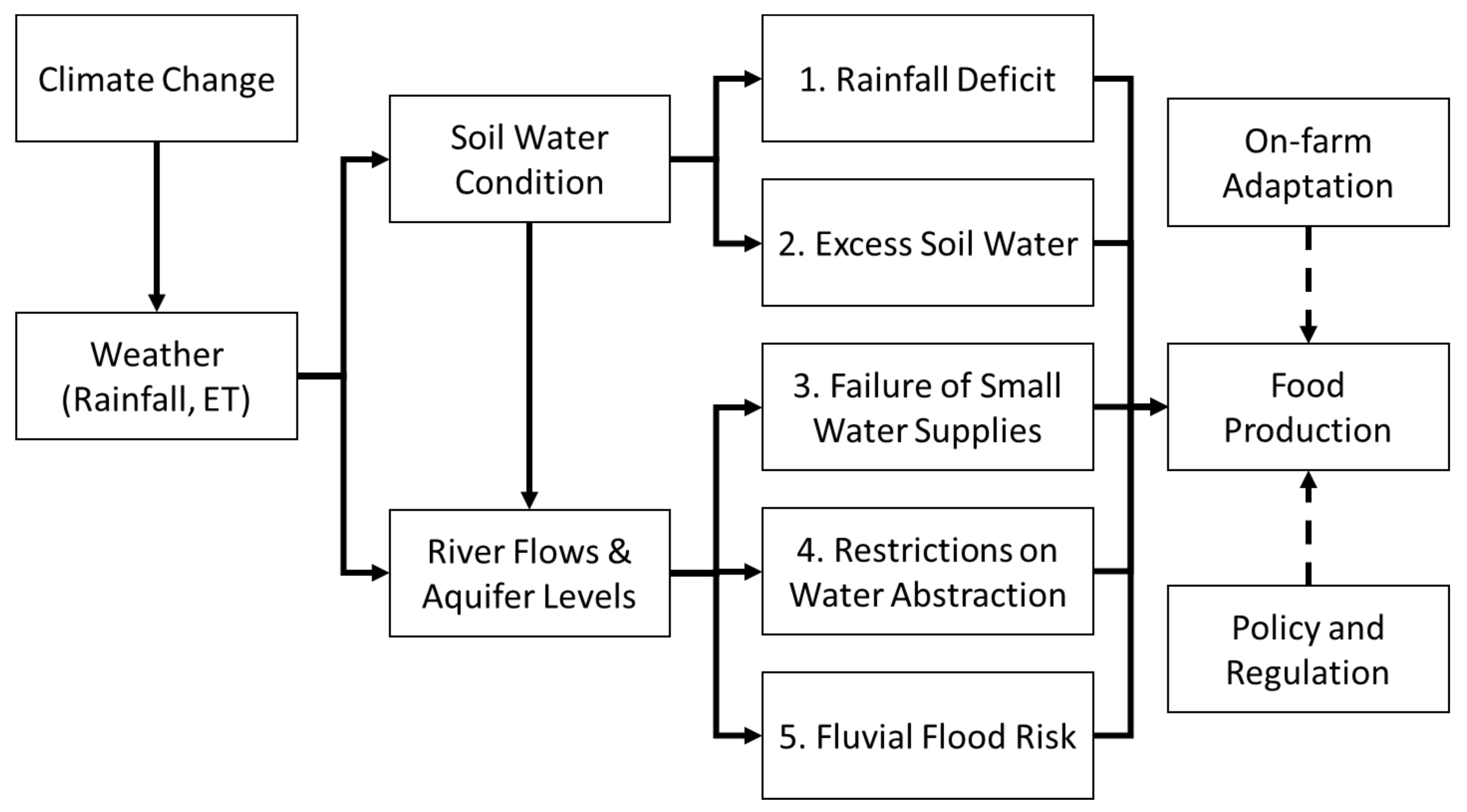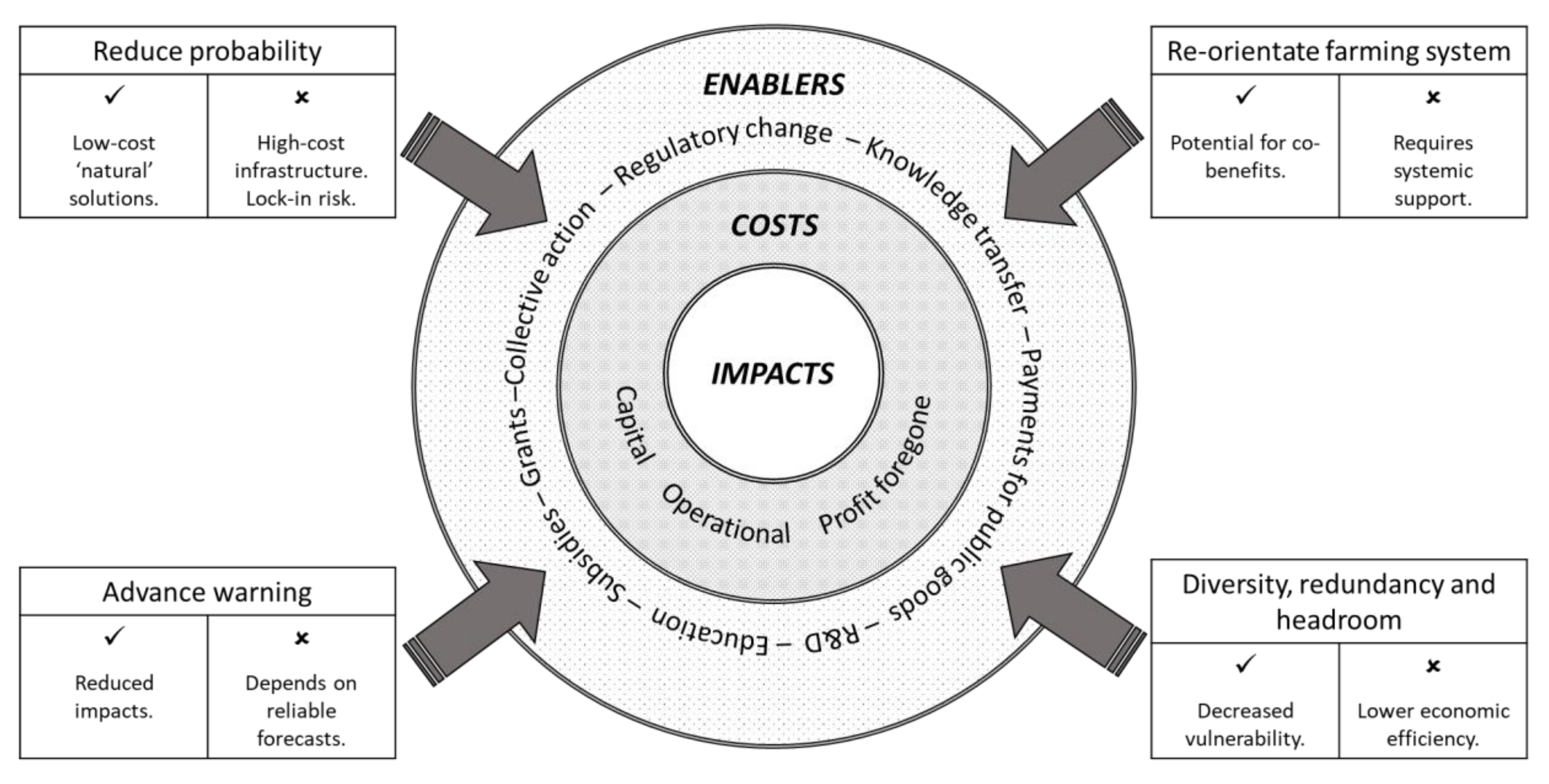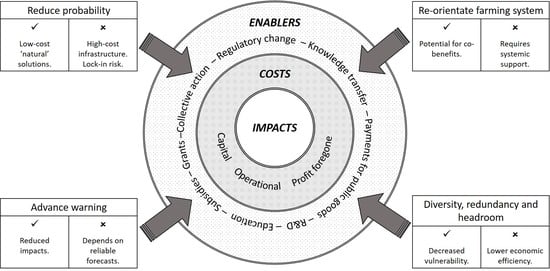Resilience of Primary Food Production to a Changing Climate: On-Farm Responses to Water-Related Risks
Abstract
1. Introduction
2. Water-Related Risks to Agriculture
2.1. Rainfall Deficit
2.2. Restrictions on Water Abstractions for Spray Irrigation
2.3. Failure of Private Water Supplies
2.4. Excess Soil Water
2.5. Fluvial Flood Risk
3. Discussion
- Supporting education and knowledge transfer. Farmers are more willing to adopt practices with which they are already familiar and have been proven to be effective.
- Grants, subsidies, or tax breaks for capital investment in technologies for water efficiency and climate adaptation.
- Water user associations or abstractor groups providing opportunities for collective action.
- Legislative enablers which promote adaptation by providing more flexible regulation at the catchment scale.
- Payments for environmental services and the conservation of natural resources.
- Collaborative funding of science and technology to enhance adaptation.
4. Conclusions
Author Contributions
Funding
Data Access
Conflicts of Interest
References
- Boltz, F.; LeRoy Poff, N.; Folke, C.; Kete, N.; Brown, C.M.; St. George Freeman, S.; Matthews, J.H.; Martinez, A.; Rockström, J. Water is a master variable: Solving for resilience in the modern era. Water Secur. 2019, 8. [Google Scholar] [CrossRef]
- IPCC. Managing the Risks of Extreme Events and Disasters to Advance Climate Change Adaptation; Field, C.B., Barros, V., Stocker, T.F., Dahe, Q., Eds.; Cambridge University Press: Cambridge, UK, 2012; ISBN 9781139177245. [Google Scholar]
- Folke, C.; Carpenter, S.R.; Walker, B.; Scheffer, M.; Chapin, T.; Rockström, J. Resilience thinking: Integrating resilience, adaptability and transformability. Ecol. Soc. 2010, 15. [Google Scholar] [CrossRef]
- Carpenter, S.; Walker, B.; Anderies, J.M.; Abel, N. From Metaphor to Measurement: Resilience of What to What? Ecosystems 2001, 4, 765–781. [Google Scholar] [CrossRef]
- Brown, I.; Thompson, D.; Bardgett, R.; Berry, P.; Crute, I.; Morison, J.; Morecroft, M.; Pinnegar, J.; Reeder, T.; Topp, K. Chapter 3: Natural Environment and Natural Assets. In UK Climate Change Risk Assessment 2017: Evidence Report; Report Prepared for the Adaptation Sub-Committee of the Committee on Climate Change; Committee on Climate Change: London, UK, 2016. [Google Scholar]
- Parsons, D.J.; Rey, D.; Tanguy, M.; Holman, I.P. Regional variations in the link between drought indices and reported agricultural impacts of drought. Agric. Syst. 2019, 173, 119–129. [Google Scholar] [CrossRef]
- UKMO. UKCP18 Science Overview Executive Summary; UKMO: Exeter, UK, 2019. [Google Scholar]
- Watts, G.; Battarbee, R.W.; Bloomfield, J.P.; Crossman, J.; Daccache, A.; Durance, I.; Elliott, J.A.; Garner, G.; Hannaford, J.; Hannah, D.M.; et al. Climate change and water in the UK—Past changes and future prospects. Prog. Phys. Geogr. 2015, 39. [Google Scholar] [CrossRef]
- Helfgott, A. Operationalising systemic resilience. Eur. J. Oper. Res. 2018, 268, 852–864. [Google Scholar] [CrossRef]
- Wilhite, D.A.; Glantz, M.H. Understanding: The Drought Phenomenon: The Role of Definitions. Water Int. 1985, 10, 111–120. [Google Scholar] [CrossRef]
- Keay, C.A.; Jones, R.J.A.; Hannam, J.A.; Barrie, I.A. The implications of a changing climate on agricultural land classification in England and Wales. J. Agric. Sci. 2014, 152, 23–37. [Google Scholar] [CrossRef]
- Knox, J.; Morris, J.; Hess, T. Identifying future risks to UK agricultural crop production: Putting climate change in context. Outlook Agric. 2010, 39, 249–256. [Google Scholar] [CrossRef]
- El Chami, D.; Daccache, A. Assessing sustainability of winter wheat production under climate change scenarios in a humid climate—An integrated modelling framework. Agric. Syst. 2015, 140, 19–25. [Google Scholar] [CrossRef]
- Daccache, A.; Keay, C.; Jones, R.J.A.; Weatherhead, E.K.; Stalham, M.A.; Knox, J.W. Climate change and land suitability for potato production in England and Wales: Impacts and adaptation. J. Agric. Sci. 2012, 150, 161–177. [Google Scholar] [CrossRef]
- Cho, K.; Falloon, P.; Gornall, J.; Betts, R.; Clark, R. Winter wheat yields in the UK: Uncertainties in climate and management impacts. Clim. Res. 2012, 54, 49–68. [Google Scholar] [CrossRef]
- Anglian Water. Water, Water Everywhere? Encouraging Collaborating and Building Partnerships; Anglian Water: Huntigdon, UK, 2013. [Google Scholar]
- Akande, K.; Hussain, S.; Knox, J.; Hess, T.; Hooftman, D.; Stratford, C.; Schafer, S.; Acreman, M.; Edwards, F. The Impacts of Drought in England; R&D Technical Report WT0987/TR; Department for Environment, Food and Rural Affairs Water Availability Division: London, UK, 2013.
- Rial-Lovera, K.; Davies, W.P.; Cannon, N.D. Implications of climate change predictions for UK cropping and prospects for possible mitigation: A review of challenges and potential responses. J. Sci. Food Agric. 2017, 97, 17–32. [Google Scholar] [CrossRef] [PubMed]
- Semenov, M.A. Impacts of climate change on wheat in England and Wales. J. R. Soc. Interface 2009, 6, 343–350. [Google Scholar] [CrossRef]
- Christy, B.; Tausz-Posch, S.; Tausz, M.; Richards, R.; Rebetzke, G.; Condon, A.; McLean, T.; Fitzgerald, G.; Bourgault, M.; O’Leary, G. Benefits of increasing transpiration efficiency in wheat under elevated CO2 for rainfed regions. Glob. Chang. Biol. 2018, 24, 1965–1977. [Google Scholar] [CrossRef]
- Stanek-Tarkowska, J.; Czyz, E.A.; Dexter, A.R.; Sławiński, C. Effects of reduced and traditional tillage on soil properties and diversity of diatoms under winter wheat. Int. Agrophys. 2018, 32, 403–409. [Google Scholar] [CrossRef]
- Johnston, A.E. Soil organic matter, effects on soils and crops. Soil Use Manag. 1986, 2, 97–105. [Google Scholar] [CrossRef]
- Eden, M.; Gerke, H.H.; Houot, S. Organic waste recycling in agriculture and related effects on soil water retention and plant available water: A review. Agron. Sustain. Dev. 2017, 37. [Google Scholar] [CrossRef]
- Green, T.R.; Ahuja, L.R.; Benjamin, J.G. Advances and challenges in predicting agricultural management effects on soil hydraulic properties. Geoderma 2003, 116, 3–27. [Google Scholar] [CrossRef]
- Hess, T.M.; Holman, I.P.; Rose, S.C.; Rosolova, Z.; Parrott, A. Estimating the impact of rural land management changes on catchment runoff generation in England and Wales. Hydrol. Process. 2010, 24, 1357–1368. [Google Scholar] [CrossRef]
- Rey, D.; Holman, I.P.; Daccache, A.; Morris, J.; Weatherhead, E.K.; Knox, J.W. Modelling and mapping the economic value of supplemental irrigation in a humid climate. Agric. Water Manag. 2016, 173, 13–22. [Google Scholar] [CrossRef]
- DEFRA. Water Usage in Agriculture and Horticulture. Results from the Farm; Business Survey 2009/10 and the Irrigation Survey 2010; Department for Environment, Food and Rural Affairs: London, UK, 2011.
- Parliament of the United Kingdom. Water Resources Act; Parliament of the United Kingdom: London, UK, 1991.
- Knox, J.W.; Morris, J.; Weatherhead, E.K.; Turner, A.P. Mapping the financial benefits of sprinkler irrigation and potential financial impact of restrictions on abstraction: A case-study in Anglian Region. J. Environ. Manag. 2000, 58, 45–59. [Google Scholar] [CrossRef]
- Salmoral, G.; Rey, D.; Rudd, A.; de Margon, P.; Holman, I. A Probabilistic Risk Assessment of the National Economic Impacts of Regulatory Drought Management on Irrigated Agriculture. Earths Futur. 2019, 7, 178–196. [Google Scholar] [CrossRef]
- Knox, J.W.; Hurford, A.; Hargreaves, L.; Wall, E. Climate Change Risk Assessment for the Agriculture Sector; Defra Project Code GA0204; Department for Environment, Food and Rural Affairs: London, UK, 2012.
- Rio, M.; Rey, D.; Prudhomme, C.; Holman, I.P. Evaluation of changing surface water abstraction reliability for supplemental irrigation under climate change. Agric. Water Manag. 2018, 206, 200–208. [Google Scholar] [CrossRef]
- Rey, D.; Holman, I.P.; Knox, J.W. Developing drought resilience in irrigated agriculture in the face of increasing water scarcity. Reg. Environ. Chang. 2017, 17, 1527–1540. [Google Scholar] [CrossRef]
- Perry, C. Efficient irrigation; inefficient communication; flawed recommendations. Irrig. Drain. 2007, 56, 367–378. [Google Scholar] [CrossRef]
- Hess, T.M.; Knox, J.W. Water savings in irrigated agriculture: A framework for assessing technology and management options to reduce water losses. Outlook Agric. 2013, 42. [Google Scholar] [CrossRef]
- Gadanakis, Y.; Bennett, R.; Park, J.; Areal, F.J. Improving productivity and water use efficiency: A case study of farms in England. Agric. Water Manag. 2015, 160, 22–32. [Google Scholar] [CrossRef]
- Grafton, R.Q.; Williams, J.; Perry, C.J.; Molle, F.; Ringler, C.; Steduto, P.; Udall, B.; Wheeler, S.A.; Wang, Y.; Garrick, D.; et al. The paradox of irrigation efficiency. Science 2018, 361, 748–750. [Google Scholar] [CrossRef]
- ADAS. Water for Irrigation. Ministry of Agriculture; Fisheries and Food Reference Book 202; HMSO: London, UK, 1977. [Google Scholar]
- Hess, T.M.; Knox, J.W.; Kay, M.G.; Weatherhead, E.K. Managing the Water Footprint of Irrigated Food Production in England and Wales. In Sustainable Water; Issues in Environmental Science and Technology, 31; Hester, R.E., Harrison, R.M., Eds.; Royal Society of Chemistry: London, UK, 2010; pp. 78–92. ISBN 978-1-84973-225-3. [Google Scholar]
- Weatherhead, E.K.; Knox, J.W.; Daccache, A.; Morris, J.; Groves, S.; Hulin, A.; Kay, M.G. Water for Agriculture: Collaborative Approaches and On-Farm Storage; FFG1112 Final Report; Cranfield University: Cranfield, UK, 2014. [Google Scholar]
- Rey, D.; Pérez-Blanco, C.D.; Escriva-Bou, A.; Girard, C.; Veldkamp, T.I.E. Role of economic instruments in water allocation reform: Lessons from Europe. Int. J. Water Resour. Dev. 2019, 35, 206–239. [Google Scholar] [CrossRef]
- Holman, I.P.; Trawick, P. Developing adaptive capacity within groundwater abstraction management systems. J. Environ. Manag. 2011, 92, 1542–1549. [Google Scholar] [CrossRef] [PubMed]
- Tyrrel, S.F.; Knox, J.W.; Burton, C.H.; Weatherhead, E.K. Assuring the Microbiological Quality of Water Used to Irrigate Salad Crops: An Assessment of the Options Available; Horticultural Development Council Report FV 248; Cranfield University: Cranfield, UK, 2004. [Google Scholar]
- DEFRA. Water Usage on Farms. Results from the Farm; Business Survey, England 2015/16; Department for Environment, Food and Rural Affairs: London, UK, 2017.
- King, J.; Tiffin, D.; Drakes, D.; Smith, K.; Weatherhead, E.K. Water Use in Agriculture: Establishing a Baseline; Defra Project WU0102; Department for Environment, Food and Rural Affairs: London, UK, 2006.
- Knox, J.W.; Rickson, R.J.; Weatherhead, E.K.; Hess, T.M.; Deeks, L.K.; Truckell, I.J.; Keay, C.A.; Brewer, T.R.; Daccache, A. Provision of Research to Develop the Evidence Base on Soil Erosion and Water Use in Agriculture; Cranfield University for the Adaptation Sub-Committee; Cranfield University: Cranfield, UK, 2015. [Google Scholar]
- DWI. Legislation of Private Water Supplies and Drought; Drinking Water Inspectorate: London, UK, 2012. [Google Scholar]
- DEFRA. Identification and Knowledge Transfer of Novel and Emerging Technology with the Potential to Improve Water Use Efficiency within English and Welsh Agriculture; Defra Project WU0123; Department for Environment, Food and Rural Affairs: London, UK, 2009.
- Holman, I.P.; Hollis, J.M.; Bramley, M.E.; Thompson, T.R.E. The contribution of soil structural degradation to catchment flooding: A preliminary investigation of the 2000 floods in England and Wales. Hydrol. Earth Syst. Sci. 2003, 7, 755–766. [Google Scholar] [CrossRef][Green Version]
- Jones, M.R.; Fowler, H.J.; Kilsby, C.G.; Blenkinsop, S. An assessment of changes in seasonal and annual extreme rainfall in the UK between 1961 and 2009. Int. J. Climatol. 2013, 33, 1178–1194. [Google Scholar] [CrossRef]
- Fowler, H.J.; Ekström, M. Multi-model ensemble estimates of climate change impacts on UK seasonal precipitation extremes. Int. J. Climatol. 2009, 29, 385–416. [Google Scholar] [CrossRef]
- Guillod, B.P.; Jones, R.G.; Dadson, S.J.; Coxon, G.; Bussi, G.; Freer, J.; Kay, A.L.; Massey, N.R.; Sparrow, S.N.; Wallom, D.C.H.; et al. A large set of potential past, present and future hydro-meteorological time series for the UK. Hydrol. Earth Syst. Sci. 2018, 22, 611–634. [Google Scholar] [CrossRef]
- ADAS. Development of a Database of Agricultural Drainage; Defra Project ES0111; ADAS: London, UK, 2002. [Google Scholar]
- Posthumus, H.; Morris, J.; Hess, T.M.; Neville, D.; Phillips, E.; Baylis, A. Impacts of the summer 2007 floods on agriculture in England. J. Flood Risk Manag. 2009, 2, 182–189. [Google Scholar] [CrossRef]
- Morris, J.; Brewin, P. The impact of seasonal flooding on agriculture: The spring 2012 floods in Somerset, England. J. Flood Risk Manag. 2014, 7, 128–140. [Google Scholar] [CrossRef]
- Twining, S. Impact of 2014 Winter Floods on Agriculture in England; ADAS report for Defra; ADAS: London, UK, 2014. [Google Scholar]
- Alfieri, L.; Dottori, F.; Betts, R.; Salamon, P.; Feyen, L. Multi-model projections of river flood risk in Europe under global warming. Climate 2018, 6, 6. [Google Scholar] [CrossRef]
- Roca, M.; Sayers, P.; Bast, H.; Flikweert, J.; Panzeri, M.; Ogunyoye, F.; Hess, T.M.; Young, R. Developing the Evidence Base to Describe the Flood Risk to Agricultural Land in England and Wales; R&D Technical Report FD2634/TR; Department for Environment, Food and Rural Affairs: London, UK, 2010.
- Folke, C. Resilience: The emergence of a perspective for social-ecological systems analyses. Glob. Environ. Chang. Policy Dimens. 2006, 16, 253–267. [Google Scholar] [CrossRef]
- Cabel, J.F.; Oelofse, M. An indicator framework for assessing agroecosystem resilience. Ecol. Soc. 2012, 17. [Google Scholar] [CrossRef]
- Allison, H.E.; Hobbs, R.J. Resilience, adaptive capacity, and the “lock-in trap” of the Western Australian agricultural region. Ecol. Soc. 2004, 9. [Google Scholar] [CrossRef]
- Lin, B.B. Resilience in Agriculture through Crop Diversification: Adaptive Management for Environmental Change. Bioscience 2011, 61, 183–193. [Google Scholar] [CrossRef]
- Rotz, S.; Fraser, E.D.G. Resilience and the industrial food system: Analyzing the impacts of agricultural industrialization on food system vulnerability. J. Environ. Stud. Sci. 2015, 5, 459–473. [Google Scholar] [CrossRef]
- D’Odorico, P.; Laio, F.; Ridolfi, L. Does globalization of water reduce societal resilience to drought? Geophys. Res. Lett. 2010, 37, 1–5. [Google Scholar] [CrossRef]
- Abson, D.J.; Fraser, E.D.G.; Benton, T.G. Landscape diversity and the resilience of agricultural returns: A portfolio analysis of land-use patterns and economic returns from lowland agriculture. Agric. Food Secur. 2013, 2. [Google Scholar] [CrossRef]
- Holling, C.S. Understanding the complexity of economic, ecological, and social systems. Ecosystems 2001, 4, 390–405. [Google Scholar] [CrossRef]
- Leathes, W.; Knox, J.W.; Kay, M.G.; Trawick, P.; Rodriguez-Diaz, J.A. Developing UK farmers’ institutional capacity to defend their water rights and effectively manage limited water resources. Irrig. Drain. 2008, 57, 322–331. [Google Scholar] [CrossRef]
- Rickards, L.; Howden, S.M. Transformational adaptation: Agriculture and climate change. Crop. Pasture Sci. 2012, 63, 240–250. [Google Scholar] [CrossRef]



© 2020 by the authors. Licensee MDPI, Basel, Switzerland. This article is an open access article distributed under the terms and conditions of the Creative Commons Attribution (CC BY) license (http://creativecommons.org/licenses/by/4.0/).
Share and Cite
Hess, T.; Knox, J.; Holman, I.; Sutcliffe, C. Resilience of Primary Food Production to a Changing Climate: On-Farm Responses to Water-Related Risks. Water 2020, 12, 2155. https://doi.org/10.3390/w12082155
Hess T, Knox J, Holman I, Sutcliffe C. Resilience of Primary Food Production to a Changing Climate: On-Farm Responses to Water-Related Risks. Water. 2020; 12(8):2155. https://doi.org/10.3390/w12082155
Chicago/Turabian StyleHess, Tim, Jerry Knox, Ian Holman, and Chloe Sutcliffe. 2020. "Resilience of Primary Food Production to a Changing Climate: On-Farm Responses to Water-Related Risks" Water 12, no. 8: 2155. https://doi.org/10.3390/w12082155
APA StyleHess, T., Knox, J., Holman, I., & Sutcliffe, C. (2020). Resilience of Primary Food Production to a Changing Climate: On-Farm Responses to Water-Related Risks. Water, 12(8), 2155. https://doi.org/10.3390/w12082155








